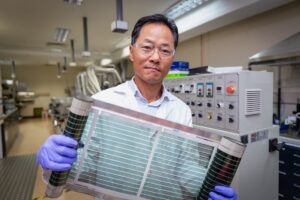If you had your hair cut at a barber’s somewhere in the vicinity of a Queensland University of Technology campus sometime last year, there’s an outside chance you could have contributed to the advancement of cutting edge Australian solar technology.
Researchers from QUT have used human hair snippets gathered from a Brisbane barber to create carbon dots – zero-dimensional carbon-based materials the size of a few tens of nanometers – which are in turn being used to improve the performance of perovskite solar cells.
Perovskite solar cells have shown great promise in the eternal global quest to deliver even lower-cost and higher efficiency solar PV electricity, but still face a number of key hurdles to commercial viability, including a lack of stability and prohibitive costs.
To this end, the team at QUT, led by Professor Hongxia Wang in collaboration with Associate Professor Prashant Sonar of the university’s Centre for Materials Science, have discovered a way to create a kind of perovskite cell “armour” using carbon nanodots created using an abundant source – human hair.
The idea came partly from separate QUT research, from a team led by Prashant Sonar and including Centre for Materials Science research fellow Amandeep Singh Pannu, that turned hair scraps into carbon nanodots by breaking them down and then burning them at 240°C.
In that study, the researchers showed the carbon dots could be turned into flexible displays that could be used in future smart devices.
Professor Wang’s team team, meanwhile, had found that nanostructured carbon materials could be used to improve a perovskite solar cell’s performance.
Bringing the two discoveries together in a new study, published late last week in the Journal of Materials Chemistry A, Wang’s team – including including Dr Ngoc Duy Pham and Centre for Materials Science research fellow Amandeep Singh Pannu – applied the hair-derived carbon nanodots to solar cells “out of curiosity.”
What the team found was that by adding a solution of carbon dots into the process of making the perovskites, they formed a wave-like perovskite layer where the perovskite crystals were surrounded by the carbon dots.
“It creates a kind of protective layer, a kind of armour,” said Professor Wang, who has been researching advanced solar cells for about 20 years and working with perovskite cells since they were invented about a decade ago.
“It protects the perovskite material from moisture or other environmental factors, which can cause damage to the materials.”
Ultimately, the study found that perovskite solar cells covered with the carbon dots had a higher power conversion efficiency and a greater stability than perovskite cells without the carbon dots.
“Our final target is to make solar electricity cheaper, easier to access, longer lasting and to make PV devices lightweight because current solar cells are very heavy,” Professor Wang said.
The finding is the latest from Australia’s perovskite-focused solar research efforts. Last year, a report published in the journal Nature Materials by scientists across the Universities of Melbourne and Sydney, as well as from Monash University in Victoria, discovered that high-intensity, glaring light could undo the same perovskite cell disruption caused by light at lower intensities.










